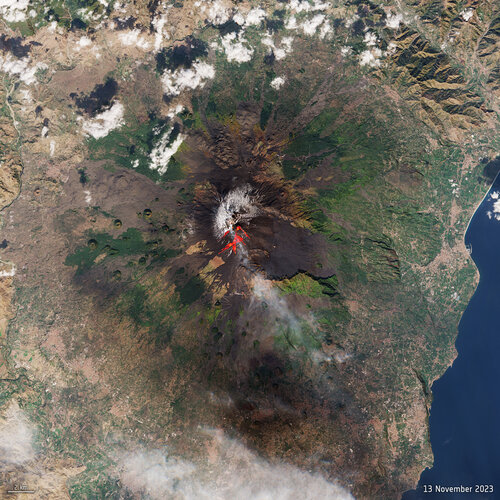One of the world’s most active volcanoes, Mount Etna, erupted on Sunday – spewing lava and clouds of ash high over the Mediterranean island of Sicily. This image, captured on 13 November by the Copernicus Sentinel-2 mission, has been processed using the mission’s shortwave-infrared bands to show the lava flow at the time of acquisition.
Standing at approximately 3329 m high, Mount Etna is an almost constant state of activity. Ash and cloud created because of frequent eruptions pose a threat to the nearby city of Catania, situated on Sicily’s coast.
Footage of the most recent event was shared on social media, showing huge plumes of molten rock and lava shot into the night sky. Despite the volcano’s activity and ash precipitation, Catania Airport has remained open.
Mount Etna isn’t the sole volcano under surveillance in Europe. Iceland is also bracing itself for an impending volcanic eruption. Earthquake swarms have been recorded in the town of Grindavik as a magma tunnel forms beneath the region – prompting the evacuation of thousands of people.
Satellite data can be used to detect the slight signs of change that may foretell an eruption. Once an eruption begins, optical and radar instruments can capture the various phenomena associated with it, including lava flows, mudslides, ground fissures and earthquakes. Atmospheric sensors on satellites can also identify the gases and aerosols released by the eruption, as well as quantify their wider environmental impact.
Learn more about how the Copernicus Sentinel satellites can detect and track volcanic gas emissions, changes in ground deformation as well as volcanic ash plumes by clicking here.



 Image:
One of the world’s most active volcanoes, Mount Etna, erupted on Sunday – spewing lava and clouds of ash high over the Mediterranean island of Sicily. This image, captured on 13 November by the Copernicus Sentinel-2 mission, has been processed using the mission’s shortwave-infrared bands
Image:
One of the world’s most active volcanoes, Mount Etna, erupted on Sunday – spewing lava and clouds of ash high over the Mediterranean island of Sicily. This image, captured on 13 November by the Copernicus Sentinel-2 mission, has been processed using the mission’s shortwave-infrared bands